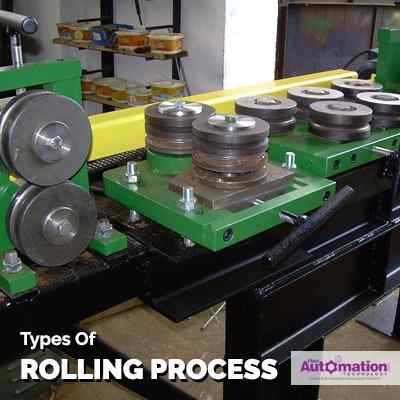Articles
Types Of Rolling Process In Manufacturing Industry

Rolling is the most important and widely used metal forming process because of its lower cost and higher productivity. The rolling process is best defined as the shaping of metals into semi-finished or finished forms by passing between rollers rotating in opposite direction. Just like any other metal forming process, rolling works in the same way. The deformation takes place when a compressive force is applied by a set of rolls on ingot or any other product like billets, blooms, sheets, slabs, plates, strips, etc. This deformation decreases the cross-section area of the metal and converts it into the required shape. The main purpose of rolling is to decrease the thickness of the metal. Steel, magnesium, aluminum, copper, and their alloys are the materials commonly rolled. As a result of the friction between the rolls and the metal surface, the metal is subjected to high compressive stresses. High production rate, grain structure, and surface-finish are obtained, which makes it a most suitable metal forming process for large length cross-section workpieces like plates and sheets of steel and aluminum for other works and structure. However, the high set up cost of the rolling machine makes it an alternative process.
The rolling process is done both hot and cold, which is accomplished in rolling mills. A rolling mill is a complex machine having two or more supporting rollers, working rollers, drive motor, roll stands, working rollers, coupling gear, flywheel, etc. According to the requirement of the process and technical issues, these rolling machines are available in different shapes and sizes. Each rolling mill consists of a minimum of two rolls. As per the process requirement, these numbers can extend even. Depending upon the shape of the rolled product, the rollers may be grooved or plain. The shape of the metal changes gradually during the period in which it's in contact with the two rollers. Compared to forging, rolling is a more economical method of deformation when metal is required in long lengths of uniform cross-section. The hot rolling process occurs with the initial breakdown of ingots into billets and blooms. This is followed by further hot rolling into the sheet, plate, bar, rod, rail, and pipe. It's done at the above recrystallization temperature and used for large deformations. Hot rolling gives residual stresses free product, but due to scale formation, it gives poor dimension accuracy and surface finish. A major role in the industry is played by the cold-rolling of metals by providing sheet, strip, foil with high mechanical strength, good surface finish, along with dimension accuracy. The cold rolling which is done to get the final product is done at below recrystallization temperature. We shall discuss here the types of rolling process and its applications in the manufacturing industry.
| Read More: Boosting Efficiency: Exploring Future Trends in Rolling Operations |
Types Of Rolling
The types of the rolling process can be classified into the following ways-
- Thread/Gear Rolling
- Shape Rolling
- Ring Rolling
- Tube Piercing
- Transverse Rolling/Roll Forging
- Skew Rolling
- Roll Bending
- Flat Rolling
- Controlled Rolling
A) Thread/Gear Rolling
The thread/gear rolling is a cold-forming type of rolling process used to cut gear or threads on a cylindrical blank. In this process, the threaded dies are fitted on cylindrical rollers of the rolling machine. The cylindrical blank presses the threaded roller and roll against the faces, which displace the material and form threads on the cylindrical blank. The thread-rolling process has the benefit of generating threads with high strength (due to cold working), without any material loss (scrap) and good surface finish. The thread/gear rolling is used for the production of screws, bolts, etc. in mass quantities.
B) Shape Rolling/Structural Shape Rolling/Profile Rolling
The shape rolling is used to cut different shapes on the metal workpiece. It does not involve any significant change in thickness. It’s a special type of cold rolling that is suitable for producing molded sections such as irregular shaped channels and trim. It's used to roll construction shapes such as I-beams, L-beams, and U channels, rails for railroad tracks, and round and square bars and rods, etc. The applications of shape rolling are -
- Construction materials
- Ceiling panel
- Metal furniture
- Household appliances
- Partition beam
- Steel pipe
- Automotive parts
- Roofing panels
- Door and window frames and other metal products
C) Ring Rolling
Ring rolling is a type of hot rolling that increases the diameter of a ring. Two rollers i.e. main and idler are arranged and rotated in the same direction to each other in this process. Due to the rotation of the roller, the ring rotates and the rollers then start moving close to each other, with a decrease in ring thickness and hence this results in an increase in its diameter. To maintain the height of the ring, a pair of edge rollers are used, which does not allow metal flow in the direction of height. This process gives material finish and high accuracy. Common applications of ring rolling include -
- Large bearings
- Turbines
- Airplanes
- Railway tyres
- Gears
- Rockets
- Pipes
- Pressure vessels
D) Tube Piercing
Tube piercing is another rolling process in which you can find a stationary mandrel at the center of tube and cavity form, due to tensile stress in a cylindrical rod when subjected to external compressive stress. Two rolls are rotated in the opposite direction in this process which compresses the tube and feeds it against mandrel which creates a hollow cavity in it. This process is used to make seamless hollow tubes of a thick wall.
E) Transverse Rolling/ Roll Forging
Also called cross rolling, which is used to produce table knives, leaf springs, tapered shafts, and hand tools. In this process, both rollers rotate in the same direction and the heated bar is cut to length and is fed transversely between rolls. Usually, circular wedge rolls are used in the transverse rolling.
F) Skew Rolling
This is a process similar to roll forging. Typically used for making ball bearings. In this process, round wire or bar is fed directly into specially designed rollers which continuously form spherical balls by rolling action. Used for the mass production of small size spherical balls.
G) Roll Bending
In roll bending, a cylindrical shaped product is produced from plate or steel metals. The rolls change shape during rolling because of the forces acting on them, which tends to bend the elasticity of the rolls during rolling. If the elastic modulus of the roll material is high, then the roll deflection would be smaller. Compared to its edges, the rolled strip tends to be thicker at the center. We can avoid this problem by grinding the rolls in such a way that their diameter at the center is slightly larger than at their edges.
H) Flat Rolling
This is the most basic form of rolling in which the starting and end material both have a rectangular cross-section. The material is fed in between two rollers, that rotate in opposite directions. The two rollers in flat rolling are called working rolls. The gap between the two rolls is less than the thickness of the starting material, which causes the deformity of it. The material, which is pushed through due to the friction at the interface between the material and the rolls, even elongates due to the decrease in material thickness. However, the friction between the rolls limits the amount of deformation possible in a single pass. The rolls just slip over the material and do not draw it in if the change in thickness is too great.
I) Controlled Rolling
It’s a type of thermo-mechanical processing which combines heat treating and controlled deformation. The workpiece is brought above the recrystallization temperature with the help of heat, which performs the heat treatments to avoid any subsequent heat treating. Controlling the nature, size, and distribution of various transformation products; production of a fine grain structure; controlling the toughness; inducing precipitation hardening are some of the types of heat treatments included. The entire process must be closely monitored and controlled, to achieve this. The deformation levels, cool-down conditions, starting material composition and structure, the temperature at various stages are the common variables in controlled rolling. Better mechanical properties and energy savings are the benefits of controlled rolling.







